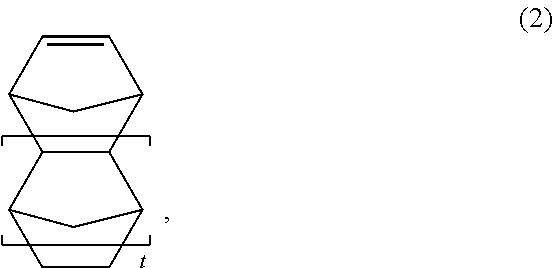Photoresist composition containing a protected hydroxyl group for negative development and pattern forming method using thereof
a technology of hydroxyl group and composition, which is applied in the field of photolithography, can solve the problems of becoming ever more difficult to print small features, and achieve the effect of negative developmen
- Summary
- Abstract
- Description
- Claims
- Application Information
AI Technical Summary
Benefits of technology
Problems solved by technology
Method used
Image
Examples
example 1
Synthesis of Acid Labile Groups Protected Polymer of 3-hydroxy-1-adamantyl methacrylate (Polymer A)
[0052]To a round bottom flask equipped with a condenser, a thermometer, an argon inlet and a magnetic stirrer bar, 3-hydroxy-1-adamantyl methacrylate (HAdMA) monomer (3.546 g, 0.015 mole), 2,2′-azobis(2-methylpropionitrile (AIBN) (0.172 g, 7% of total moles of monomer), and ˜15 g of tetrahydrofuran (THF) were added. The reaction mixture was stirred at room temperature and bubbled with Ar flow for 45 minutes prior to turning on the heating mantle. The reaction was carried out at 72° C. under Ar inert atmosphere overnight. Then the reaction solution was cooled to room temperature and precipitated in hexane. The precipitated polymer was filtered and washed with hexane. The collected solid was dried by vacuum oven at 40° C. overnight.
[0053]1.4 g of the above obtained polymer was dissolved in 18.9 g of PGMEA in a round bottom flask. To the polymer solution approximately 40 mg of p-toluenesu...
example 2
Synthesis of Dihydropyrane Protected Copolymer of 3-(2-hydroxyethoxy)-1-adamantyl methacrylate and 5-methacryloyloxy-2,6-norbornanecarbo-gamma-lactone (Polymer B)
[0054]To a round bottom flask equipped with a condenser, a thermometer, an argon inlet and a magnetic stirrer bar, 3-(2-hydroxyethoxy)-1-adamantyl methacrylate (HEAdMA) monomer (4.44 g, 0.02 mole), 5-methacryloyloxy-2,6-norbornanecarbo-gamma-lactone (NLM) monomer (5.61 g, 0.02 mole), AIBN (0.328 g, 5% of total moles of monomers), and ˜40 g of THF were added. The reaction mixture was stirred at room temperature and bubbled with Ar flow for 45 minutes prior to turning on the heating mantle. The reaction was carried out at 72° C. under Ar inert atmosphere overnight. Then the reaction solution was cooled to room temperature and precipitated in DI water. The precipitated polymer was filtered and washed with DI water. The collected solid was dried by vacuum oven at 65° C. overnight.
[0055]2 g of the above obtained polymer was diss...
example 3
Synthesis of Dihydropyrane Protected Copolymer of 3-hydroxy-1-adamantyl methacrylate and 5-methacryloyloxy-2,6-norbornanecarbo-gamma-lactone (Polymer C)
[0056]To a round bottom flask equipped with a condenser, a thermometer, an argon inlet and a magnetic stirrer bar, HAdMA monomer (3.552 g, 0.016 mole), NLM monomer (5.674 g, 0.024 mole), AIBN (0.394 g, 6% of total moles of monomers), and ˜30 g of THF were added. The reaction mixture was stirred at room temperature and bubbled with Ar flow for 45 minutes prior to turning on the heating mantle. The reaction was carried out at 72° C. under Ar inert atmosphere overnight. Then the reaction solution was cooled to room temperature and precipitated in DI water. The precipitated polymer was filtered and washed with DI water. The collected solid was dried by vacuum oven at 65° C. overnight.
[0057]3 g of the above obtained polymer was dissolved in 17 g of PGMEA in a round bottom flask. To the polymer solution approximately 3.7 mg of p-toluenesul...
PUM
| Property | Measurement | Unit |
|---|---|---|
| temperature | aaaaa | aaaaa |
| wt. % | aaaaa | aaaaa |
| wt. % | aaaaa | aaaaa |
Abstract
Description
Claims
Application Information
 Login to View More
Login to View More - R&D
- Intellectual Property
- Life Sciences
- Materials
- Tech Scout
- Unparalleled Data Quality
- Higher Quality Content
- 60% Fewer Hallucinations
Browse by: Latest US Patents, China's latest patents, Technical Efficacy Thesaurus, Application Domain, Technology Topic, Popular Technical Reports.
© 2025 PatSnap. All rights reserved.Legal|Privacy policy|Modern Slavery Act Transparency Statement|Sitemap|About US| Contact US: help@patsnap.com



